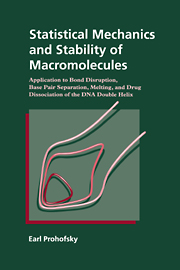 Statistical Mechanics and Stability of Macromolecules
Statistical Mechanics and Stability of Macromolecules Published online by Cambridge University Press: 16 September 2009
Anomalous stability of poly(dA)–poly(dT)
The four DNA bases come in two sizes. The larger bases, adenine and guanine, are variants of the purine structure which is a double ring structure (Saenger, 1984). The smaller two bases, thymine and cytosine, are pyrimidine variants with a single ring. The base pairing scheme requires one purine and one pyrimidine in each pair making the total span the same for all complementary base pairs. The total molecular mass of the two pairs is almost identical as well. The difference in size makes the overlap of neighbor bases different in homopolymers compared to copolymers. In homopolymers a purine is stacked above another purine and pyrimidines above pyrimidines. The interbase gap undergoes helical twist but tends to be continuous, as seen in Figure 9–6 in Saenger (1984). In the copolymers the gap moves from one side of the twisting center line to the other depending on which side is the purine or which the pyrimidine. This shifting coupled with the helical twist in the copolymers causes considerable overlap of atoms of the large bases from one level to the next in every second base pair. The overlap is between bases on different strands in the copolymer and the van der Waals stacking interactions at the overlap becomes a cross strand interaction. The copolymer has these large interstrand interactions but the homopolymer does not. One would therefore expect that copolymers with this added cross strand interaction would be more stable against strand separation melting than homopolymers.
To save this book to your Kindle, first ensure no-reply@cambridge.org is added to your Approved Personal Document E-mail List under your Personal Document Settings on the Manage Your Content and Devices page of your Amazon account. Then enter the ‘name’ part of your Kindle email address below. Find out more about saving to your Kindle.
Note you can select to save to either the @free.kindle.com or @kindle.com variations. ‘@free.kindle.com’ emails are free but can only be saved to your device when it is connected to wi-fi. ‘@kindle.com’ emails can be delivered even when you are not connected to wi-fi, but note that service fees apply.
Find out more about the Kindle Personal Document Service.
To save content items to your account, please confirm that you agree to abide by our usage policies. If this is the first time you use this feature, you will be asked to authorise Cambridge Core to connect with your account. Find out more about saving content to Dropbox.
To save content items to your account, please confirm that you agree to abide by our usage policies. If this is the first time you use this feature, you will be asked to authorise Cambridge Core to connect with your account. Find out more about saving content to Google Drive.